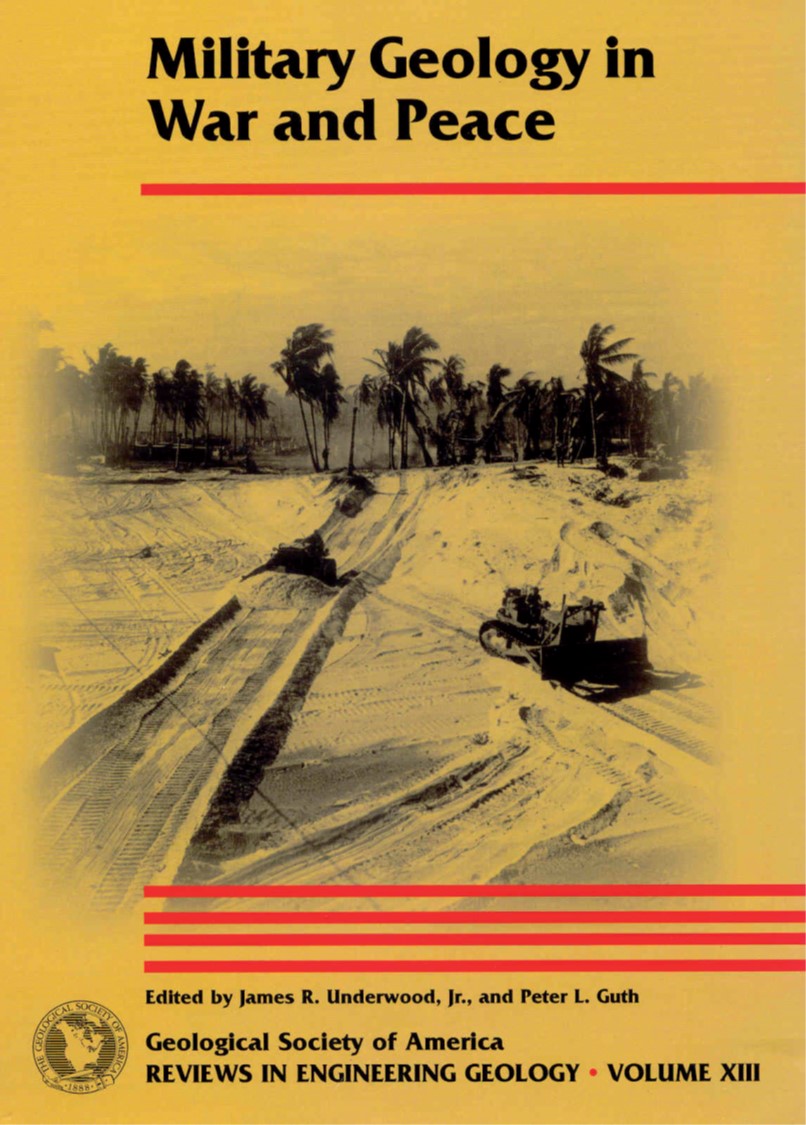Seattle, USA, 1994
(Conference summary reproduced with permission; original text published in: Häusler, H. 2009. Report on National and International Military Geo-Conferences held from 1994 to 2007, MILGEO, Nr. 30E, Austrian Ministry of Defence and Sports).

The 1st International Conference on Military Geosciences (ICMG) was hosted under the auspirces of the “Engineering Geology Division Symposium” of the Annual Meeting of the Geological Society of America on October 26, 1994. Held in Seattle it comprised one-day of lectures on “Military Geology in War and Peace”, split between the morning session (Part I: 12 lectures) and at the afternoon session (Part II: 14 lectures). The contributions are listed in Table 1. Twenty-seven authors provided twenty-five papers. Besides contributions from the U.S. only few were presented from UK and France.
Cover of the conference proceedings of the 1994 “Annual Meeting” of the Geological Society of America on “Military Geology in War and Peace”, held in Seattle, USA (UNDERWOOD & GUTH, 1998). Twenty-seven authors published twenty-five papers.The 1994 proceedings contain twenty-four chapters organised in six sections. The first 11 chapters cover selected aspects of the history of military geology in Great Britain and America in World War I and World War II, in the Korean War and in the Gulf War. Three chapters deal with the more recent status of geology in the military, covering applications of military geology in the British armed forces, geologic education in the United States, and support of the military by the U.S. Geological Survey. In the third section, three chapters discuss terrain analysis, highlighting the importance of playas in military operations, the relationship between military terrain analysis and remote sensing to specifi c military examples, and the use of remote sensing to characterize fracture patterns in politically or geographically inaccessible areas. The last three chapters provide examples of the variety of engineering applications of military geology, including geologic aspects for the siting of underground facilities, designing and locating airfields, and a history of the construction of the Distant Early Warning (DEW) Line. The use of military geology for diplomacy and peacekeeping is discussed in the three chapters of the fi fth section. The final chapter explores the future relations of military geology to the U.S. Army.
To sum it up: in warfare military geologists pursue five main categories of work: tactical and strategic, terrain analysis, fortifi cations and tunnelling, resource acquisition, defence installations, and field construction and logistics. In peace they train for wartime operations and may be involved in peacekeeping and nation-building exercises. The classic dilemma for military geology has been whether support can best be provided by civilian technical matters experts or by uniformed soldiers who routinely work with the combat units (UNDERWOOD & GUTH, 1998).
The one-day lectures on “Military Geology in War and Peace” (Table 1) were published by the USGS as volume XIII of the Reviews in Engineering Geology.
The United States Geological Survey (USGS) is a scientific agency of the United States government, which was created in 1879. It was charged with the “classifi cation of the public lands, and examination of the geological structure, mineral resources, and products of the national domain.” The USGS informs authorities, emergency responders, the media, and the public, both domestic and worldwide, about signifi cant earthquakes. It is also the primary civilian (topographic) mapping agency in the United States. Since 1962, it has been involved in global, lunar and planetary exploration and mapping. In addition, it operates the National Wildlife Health Centre.
The “Reviews in Engineering Geology” series was expanded in 1997 to include “Engineering Geology Case Histories”, 11 volumes of which were published by the Geological Society of America from 1957 to 1978. Beginning with Volume IX, the “Reviews in Engineering Geology” include both reviews and case histories.
Table 1 – Papers
| Author | Title | Subject |
|---|---|---|
| BAEHR | Potable water well design for Humanitarian Civic Action well drilling missions | Hydrogeology |
| CAMERON | Clandestine Tunnel-4, northern Punchbowl, Korean Demilitarized Zone | Geology, Korea |
| CAMERON | Dearly bought ridges, steep access valleys, and staging grounds: The military geology of the eastern DMZ, central Korean Peninsula | Geology, Korea |
| CORWIN | Engineer intelligence and the Pacific geologic mapping program | Geology, USGS, Pacific |
| DE GOES & NEAL |
Selected military geology programs in the Arctic, 1950 – 1970 | Geology, Arctic |
| EASTLER, PERCIOUS & FISHER |
Role of geology in assessing vulnerability of underground fortifications to conventional weapons attack | Geology, engineering geology |
| EHLEN | A proposed method for characterizing fracture patterns in denied areas | Geology, tectonics |
| GUTH | Military geology in war and peace: An introduction | Introduction |
| HATHEWAY & STEVENS |
Military geology should be upgraded as the U.S. Army stands down |
Geology |
| JENS & STEVENS | Geology education in the U.S. Army | Geology, education |
| KIERSCH & UNDERWOOD |
Geology and military operations, 1800 – 1960: An overview | Geology, history |
| KNOWLES & WEDGE | Military geology and the Gulf War | Geology, Gulf |
| KNOWLES | Military geology in support of nation assistance exercises in Central and South America | Geology, America |
| KRINSLEY | Location of sites for airstrips in North Greenland | Geology, Greenland |
| LEITH & MATZKO | Recent activities in military geology at the U.S. Geological Survey | Geology, USGS |
| NATHANAIL | Hydrogeological assessments of United Nations bases in Bosnia Herzegovina | Hydrogeology, Bosnia |
| NEAL | Playas and military operations | Trafficability, desert |
| NEAL | Swords into plowshares: Military geology and national security projects | Geology, National Security |
| PITTMANN | American geologists at war: World War I | Geology, WWI |
| RINKER | Remote sensing, terrain analysis, and military operations | Geology, Remote Sensing |
| ROSE & PAREYN | British applications of military geology for ´Operation Overlord` and the battle in Normandy, France, 1944 | Geology, WWII |
| ROSE & ROSENBAUM |
British military geologists through war and peace in the 19th and 20th centuries | Geology, UK |
| ROSENBAUM | Background and recent applications of military geology in the British armed forces | Geology, British Forces |
| TERMAN | Military Geology Branch of the U.S. Geological Survey from 1945 to 1972 | Geology, Cold War |
| TERMAN | Military Geology Unit of the U.S. Geological Survey during World War II | Geology, WWII |
Conference Details
Location: Seattle, USA
Dates: 26 October 1994
Conveners: –
Sponsoring Organisation: Annual Meeting of the Geological Society of America
Advisory Board: Guth, Underwood
Presenters on Programme: 27
Number of Registrants: unknown
Pre-conference Field Trip: None
Mid-conference Field Trips: None
Post-conference Field Trip: None
Proceedings Volume: Underwood, J.R. Jr., Guth, P.L. 1998. Military Geology in War and Peace. Reviews in Engineering Geology, Geological Society of America, Vol 13.
